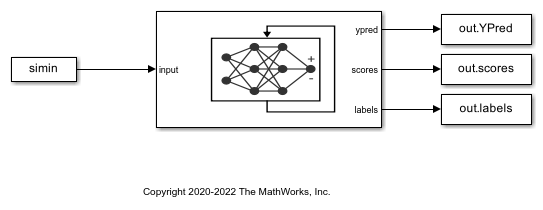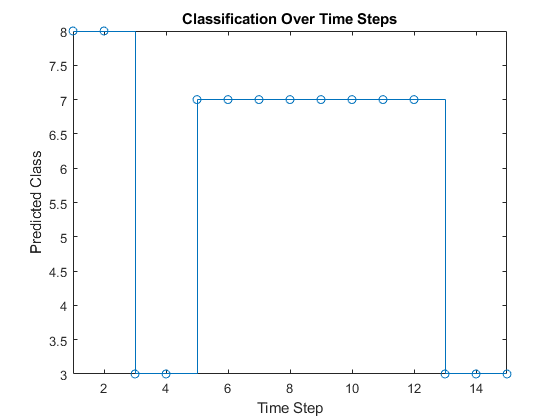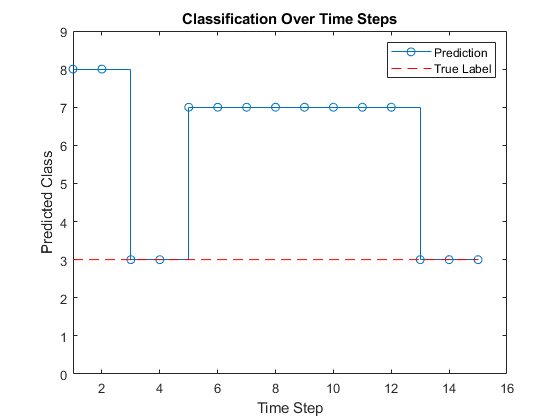Classify and Update Network State in Simulink
This example shows how to classify data for a trained recurrent neural network in Simulink® by using the Stateful Classify block. This example uses a pretrained long short-term memory (LSTM) network.
Load Pretrained Network
Load JapaneseVowelsNet, a pretrained long short-term memory (LSTM) network trained on the Japanese Vowels data set as described in [1] and [2]. This network was trained on the sequences sorted by sequence length with a mini-batch size of 27.
load JapaneseVowelsNet
View the network architecture.
analyzeNetwork(net);
Load Test Data
Load the Japanese Vowels test data. XTest is a cell array containing 370 sequences of dimension 12 of varying length. TTest is a categorical vector of labels "1","2",..."9", which correspond to the nine speakers.
Create a timetable array simin with time-stamped rows and repeated copies of X.
load JapaneseVowelsTestData; X = XTest{94}; numTimeSteps = size(X,2); simin = timetable(repmat(X,1,4)','TimeStep',seconds(0.2));
Simulink Model for Classifying Data
The Simulink model for classifying data contains a Stateful Classify block to predict the labels and From Workspace block to load the input data sequence over the time steps.
To reset the state of recurrent neural network to its initial state during simulation, place the Stateful Classify block inside a Resettable Subsystem and use the Reset control signal as trigger.
open_system('StatefulClassifyExample');

Configure Model for Simulation
Set the model configuration parameters for the Stateful Classify block.
set_param('StatefulClassifyExample/Stateful Classify','NetworkFilePath','JapaneseVowelsNet.mat'); set_param('StatefulClassifyExample','SimulationMode','Normal');
Run the Simulation
To compute responses for the JapaneseVowelsNet network, run the simulation. The prediction labels are saved in the MATLAB® workspace.
out = sim('StatefulClassifyExample');
Plot the predicted labels in a stair plot. The plot shows how the predictions change between time steps.
labels = squeeze(out.YPred.Data(1:numTimeSteps,1)); figure stairs(labels, '-o') xlim([1 numTimeSteps]) xlabel("Time Step") ylabel("Predicted Class") title("Classification Over Time Steps")

Compare the predictions with the true label. Plot a horizontal line showing the true label of the observation.
trueLabel = double(TTest(94)); hold on line([1 numTimeSteps],[trueLabel trueLabel], ... 'Color','red', ... 'LineStyle','--') legend(["Prediction" "True Label"]) axis([1 numTimeSteps+1 0 9]);

References
[1] M. Kudo, J. Toyama, and M. Shimbo. "Multidimensional Curve Classification Using Passing-Through Regions." Pattern Recognition Letters. Vol. 20, No. 11–13, pages 1103–1111.
[2] UCI Machine Learning Repository: Japanese Vowels Dataset. https://archive.ics.uci.edu/ml/datasets/Japanese+Vowels
See Also
Stateful Predict | Stateful Classify | Predict | Image Classifier